| Revision as of 21:18, 17 November 2009 editCaltas (talk | contribs)Pending changes reviewers, Rollbackers33,522 editsm Reverted 1 edit by 81.107.64.244 identified as vandalism to last revision by 82.20.46.66.← Previous edit | Latest revision as of 08:31, 4 January 2025 edit undoBeland (talk | contribs)Autopatrolled, Administrators237,209 edits →See also: consolidate links | ||
| (831 intermediate revisions by more than 100 users not shown) | |||
| Line 1: | Line 1: | ||
| {{short description|Empirical measure describing wind speed based on observed conditions}} | |||
| ] | |||
| {{Redirect|Violent storm|the video game|Violent Storm{{!}}Violent Storm}} | |||
| The '''Beaufort Scale''' ({{pronEng|ˈboʊfərt}}) is an ] measure for describing ] ] based mainly on observed sea conditions. Its full name is the '''Beaufort wind force scale''', sometimes it is incorrectly refered to as the 'Blow Force Scale'. | |||
| {{Use British English|date=July 2012}} | |||
| {{Use dmy dates|date=November 2020}} | |||
| ]-force") storm at sea, the highest rated on the Beaufort scale]] | |||
| The '''Beaufort scale''' ({{IPAc-en|ˈ|b|oʊ|f|ər|t}} {{respell|BOH|fərt}}) is an ] measure that relates ] to observed conditions at sea or on land. Its full name is the '''Beaufort wind force scale'''. | |||
| ==History== | ==History== | ||
| ]]] | |||
| The scale was created in 1805 by ], an ]-born ] ] and ]. The scale that carries Beaufort's name had a long and complex evolution, from the previous work of others, to when Beaufort was a top administrator in the Royal Navy in the 1830s. In the early 19th Century, naval officers made regular weather observations, but there was no standard scale and so they could be very subjective - one man's "stiff breeze" might be another's "soft breeze". Beaufort succeeded in getting things standardized. | |||
| The scale that carries Beaufort's name had a long and complex evolution from the previous work of others (including ] the century before). In the 18th century, naval officers made regular weather observations, but there was no standard scale and so they could be very subjective — one man's "stiff breeze" might be another's "soft breeze"—: Beaufort succeeded in standardising a scale.<ref name="Saucier-1955">{{Cite book|first=Walter Joseph |last=Saucier |year=1955 |title=Principles of Meteorological Analysis |location=Chicago |publisher=The University of Chicago Press |oclc=1082907714 }}, </ref> The scale was devised in 1805 by ] (later ]), a ] and a ] officer, while serving on {{ship|HMS|Woolwich|1785|6}}, and refined until he was ] in the 1830s, when it was adopted officially. It was first used during the 1831-1836 ] of ] under Captain ], who was later to set up the first ] in Britain giving regular weather forecasts.<ref name="met office">{{cite web|url=http://www.metoffice.gov.uk/media/pdf/4/4/Fact_Sheet_No._6_-_Beaufort_Scale.pdf|publisher=]|title=National Meteorological Library and Archive Fact sheet 6 – The Beaufort Scale|access-date=2011-05-13|url-status=dead|archive-url=https://web.archive.org/web/20121002134429/http://www.metoffice.gov.uk/media/pdf/4/4/Fact_Sheet_No._6_-_Beaufort_Scale.pdf|archive-date=2 October 2012}}</ref> | |||
| The initial scale of |
The initial scale of 13 classes (zero to 12) did not reference ] numbers, but related qualitative wind conditions to effects on the sails of a ], then the main ship of the ], from "just sufficient to give steerage" to "that which no canvas sails could withstand".<ref>{{cite book |last = Oliver |first = John E. |title = Encyclopedia of world climatology |publisher = Springer |year = 2005}}</ref> | ||
| <ref> | |||
| {{cite book | |||
| | last = Oliver | |||
| | first = John E. | |||
| | title = Encyclopedia of world climatology | |||
| | publisher = Springer | |||
| | year = 2005 | |||
| }} | |||
| </ref> At zero, all his sails would be up; at six, half of his sails would have been taken down; and at twelve, all sails would be stowed away.<ref></ref> | |||
| The scale was made a standard for ship's log entries on Royal Navy vessels in the late 1830s and, in 1853, the Beaufort scale was accepted as generally applicable at the ].<ref name="Saucier-1955"/> | |||
| The scale was made a standard for ship's log entries on Royal Navy vessels in the late 1830s and was adapted to non-naval use from the 1850s, with scale numbers corresponding to cup ] rotations. In 1906, to accommodate the growth of steam power, the descriptions were changed to how the sea, not the sails, behaved and extended to land observations. Rotations to scale numbers were standardized only in 1923. ], Director of the UK ], was responsible for this and for the addition of the land-based descriptors.<ref>{{wayback | |||
| |url=http://www.metoffice.gov.uk/education/secondary/students/beaufort.html | |||
| |date=20070927030218 | |||
| |title=Met Office: The Beaufort scale<!-- Bot generated title -->}}</ref> The measure was slightly altered some decades later to improve its utility for ]s. Today, many countries have abandoned the scale and use the ]-based units m/s or km/h instead,{{Citation needed|date=January 2008}} but the ] warnings given to public are still approximately the same as when using the Beaufort scale. | |||
| In 1916, to accommodate the growth of steam power, the descriptions were changed to how the sea, not the sails, behaved and extended to land observations. ] rotations to scale numbers were standardised only in 1923. ], ] (later Sir George Simpson), director of the ] Meteorological Office, was responsible for this and for the addition of the land-based descriptors.<ref name="met office"/> The measures were slightly altered some decades later to improve its utility for ]s. Nowadays, meteorologists typically express wind speed in kilometres or miles per hour or, for maritime and aviation purposes, ], but Beaufort scale terminology is still sometimes used in weather forecasts for shipping<ref>{{Cite book|last=McIlveen |first=Robin |year=1991 |title=Fundamentals of Weather and Climate |location=], England |publisher=Stanley Thornes |page= |isbn=978-0-7487-4079-6 }}</ref> and the ] warnings given to the public.<ref>{{Cite book|last=Hay |first=William W. |year=2016 |title=Experimenting on a Small Planet: A History of Scientific Discoveries, a Future of Climate Change and Global Warming |edition=second |location=Cham, Switzerland |publisher=Springer Verlag |page= |isbn=978-3-319-27402-7 }}</ref> | |||
| The Beaufort scale was extended in 1946, when Forces 13 to 17 were added.<ref>Walter J. Saucier (1955). Retrieved on 2009-01-09.</ref> However, Forces 13 to 17 were intended to apply only to special cases, such as tropical cyclones. Nowadays, the extended scale is only used in Taiwan and mainland China, which are often affected by typhoons. | |||
| ] | |||
| Wind speed on the 1946 Beaufort scale is based on the ]:<ref>{{cite book | title = Environmental Oceanography | author = Tom Beer | publisher = CRC Press | year = 1997 | isbn = 0849384257 | url = http://books.google.com/books?id=pgZtaB-qOmYC&pg=PA224&dq=%22Beaufort+Scale%22+0.836&lr=&as_brr=3&ei=zE-8R_qDAYjAiwHXs93VBQ&sig=-BYb90BCgJH9eCxqj5FDLJYk3kY }}</ref> | |||
| Wind speed on the Beaufort scale is based on the ]:<ref>{{Cite book|first=Tom |last=Beer |year=1997 |title =Environmental Oceanography |publisher=CRC Press |isbn=0-8493-8425-7 | url = https://books.google.com/books?id=pgZtaB-qOmYC&q=%22Beaufort+Scale%22+0.836&pg=PA224}}</ref> | |||
| * ''v'' = 0.836 ''B''<sup>3/2</sup> ] | |||
| * ''v'' = 1.625 ''B''<sup>3/2</sup> ] (<math>=\frac{13} {8} \sqrt{B^3}</math>) | |||
| where ''v'' is the equivalent wind speed at 10 metres above the sea surface and ''B'' is Beaufort scale number. For example, ''B'' = 9.5 is related to 24.5 m/s which is equal to the lower limit of "10 Beaufort". Using this formula the highest winds in hurricanes would be 23 in the scale. F1 ]es on the ] and T2 ] also begin roughly at the end of level 12 of the Beaufort scale, but are independent scales, although the TORRO scale wind values are based on the 3/2 power law relating wind velocity to Beaufort force.<ref>{{cite web |last = Maiden |first = Terence |title = T-Scale: Origins and Scientific Basis |publisher = TORRO |url = http://www.torro.org.uk/TORRO/severeweather/Tscaleorigin.php |access-date = 2012-01-04 |url-status = dead |archive-url = https://web.archive.org/web/20120205020044/http://www.torro.org.uk/TORRO/severeweather/Tscaleorigin.php |archive-date = 5 February 2012}}</ref> | |||
| : ''v'' = 0.836 ''B''<sup>3/2</sup> ] | |||
| ]s in the scale are for conditions in the open ocean, not along the shore. | |||
| where ''v'' is the equivalent wind speed at 10 meters above the sea surface and ''B'' is Beaufort scale number. For example, ''B'' = 9.5 is related to 24.5 m/s which is equal to the lower limit of "10 Beaufort". Using this formula the highest winds in hurricanes would be 23 in the scale. | |||
| == Modern scale == | |||
| Today, hurricane force winds are sometimes described as Beaufort scale 12 through 16, very roughly related to the respective category speeds of the ], by which actual ]s are measured, where Category 1 is equivalent to Beaufort 12. However, the extended Beaufort numbers above 13 do not match the Saffir-Simpson Scale. Category 1 ]es on the ] and ] scales also begin roughly at the end of level 12 of the Beaufort scale but are indeed independent scales. | |||
| The leftmost column gives the Beaufort scale number, followed by a description, wind speed, wave height, sea conditions, land conditions, photo of the sea, and the associated warning flag. | |||
| {| class="wikitable" | |||
| Note that wave heights in the scale are for conditions in the open ], not along the shore. | |||
| ==The modern scale== | |||
| <!-- Please add description row to explain meaning of columns --> | |||
| {| classfthf="wikitabtfhle" bordgerttfth="1" | |||
| ! rowspftgftghan="2" | b rser150" | Sea conditions !!rowsthfpan="2"fgthftg width="150ftutyuyfuyu"|Land conditions!!rowspan="ttgfg2"|Sea state photo | |||
| |- | |- | ||
| |+Beaufort scale<ref>{{Cite web|title=The Beaufort Scale|url=https://www.rmets.org/metmatters/beaufort-scale|access-date=2021-07-06|website=RMetS|language=en}}</ref><ref>{{cite web| title = Beaufort wind force scale| url = http://www.metoffice.gov.uk/guide/weather/marine/beaufort-scale| publisher = Met Office| access-date = 27 November 2015}}</ref><ref>{{cite web| title = Beaufort Scale| url = http://www.rmets.org/weather-and-climate/observing/beaufort-scale| publisher = Royal Meteorological Society| access-date = 27 November 2015}}</ref><ref>{{cite encyclopedia| title = Beaufort Scale| url = https://www.britannica.com/science/Beaufort-scale| encyclopedia = Encyclopædia Britannica| access-date = 27 November 2015}}</ref> | |||
| !width="70"|[[kilometre | |||
| per hour|km/h]]!!width="70"|]!!width="70"|]!!width="70"|]!!width="70"|] !!width="70"|] | |||
| |- | |- | ||
| ! Beaufort<br />number !! Description !! Wind speed !! Wave<br />height !! width="180" | Sea conditions !! width="120"|Land conditions !! Sea conditions<br />(photo) !! Associated<br />warning flag | |||
| ! style="background-color: #77FF99;" | 3 | |||
| | Gentle brheeze || 12 – 19 || 8 – 12 || 7 – 10 || 3.4 – 5.4 || 0.5 – 1 || 2 – 3.5 || Large wavelets. Crests begin to break; scattered whitecaps|| Leaves and smaller twigs in monant motion. || ] | |||
| |- | |- | ||
| ! |
!style="background-color: #FFFFFF; font-size: large;" id="Beaufort_Number_0"| 0 | ||
| | Calm | |||
| | Moderate breeze || 20 – 28 || 13 | |||
| | < 1 ]<br>< 1 ]<br>< 1 ]<br> 0–0.2 ] | |||
| – 17 || 11 – 15 || 5.5 – 7.9 || 1 – 2 || 3.5 – 6 || Small waves with breaking crests. Fairly frequent white horses. || Dust and loose paper raised. Small branches begin to move. || ] | |||
| | 0 ft<br>0 m | |||
| | Sea like a mirror | |||
| | Smoke rises vertically | |||
| | ] | |||
| | | |||
| |- | |- | ||
| ! |
!style="background-color: #AEF1F9; font-size: large;" id="Beaufort_Number_1"| 1 | ||
| | Light air | |||
| | Fresh breeze || 29 – 38 || 18 – 24 || 16 – 20 || 8.0 – 10.7 || 2 – 3 || 6 – 9 || Moderate waves of some length. Many white horses. Small amounts of spray. || Branches of a moderate size move. Small trees begin to sway. || ] | |||
| | 1–3 knots<br>1–3 mph<br>1–5 km/h<br>0.3–1.5 m/s | |||
| | 0–1 ft<br>0–0.3 m | |||
| | Ripples with appearance of scales are formed, without foam crests | |||
| | Direction shown by smoke drift but not by wind vanes | |||
| | ] | |||
| | | |||
| |- | |- | ||
| ! |
!style="background-color: #96F7DC; font-size: large;" id="Beaufort_Number_2"| 2 | ||
| | Light breeze | |||
| olor: #99CC00;" | 6 | |||
| | 4–6 knots<br>4–7 mph<br>6–11 km/h<br>1.6–3.3 m/s | |||
| | 1–2 ft<br>0.3–0.6 m | |||
| | Small wavelets still short but more pronounced; crests have a glassy appearance but do not break | |||
| | Wind felt on face; leaves rustle; ] moved by wind | |||
| | ] | |||
| | | |||
| |- | |||
| !style="background-color: #96F7B4; font-size: large;" id="Beaufort_Number_3"| 3 | |||
| | Gentle breeze | |||
| | 7–10 knots<br>8–12 mph<br>12–19 km/h<br>3.4–5.4 m/s | |||
| | 2–4 ft<br>0.6–1.2 m | |||
| | Large wavelets; crests begin to break; foam of glassy appearance; perhaps scattered white horses | |||
| | Leaves and small twigs in constant motion; light flags extended | |||
| | ] | |||
| | | |||
| |- | |||
| !style="background-color: #6FF46F; font-size: large;" id="Beaufort_Number_4"| 4 | |||
| | Moderate breeze | |||
| | 11–16 knots<br>13–18 mph<br>20–28 km/h<br>5.5–7.9 m/s | |||
| | 3.5–6 ft<br>1–2 m | |||
| | Small waves becoming longer; fairly frequent white horses | |||
| | Raises dust and loose paper; small branches moved | |||
| | ] | |||
| | | |||
| |- | |||
| !style="background-color: #73ED12; font-size: large;" id="Beaufort_Number_5"| 5 | |||
| | Fresh breeze | |||
| | 17–21 knots<br>19–24 mph<br>29–38 km/h<br>8–10.7 m/s | |||
| | 6–10 ft<br>2–3 m | |||
| | Moderate waves taking a more pronounced long form; many white horses are formed; chance of some spray | |||
| | Small trees in leaf begin to sway; crested wavelets form on inland waters | |||
| | ] | |||
| | | |||
| |- | |||
| !style="background-color: #A4ED12; font-size: large;" id="Beaufort_Number_6"| 6 | |||
| | Strong breeze | |||
| | 22–27 knots<br>25–31 mph<br>39–49 km/h<br>10.8–13.8 m/s | |||
| | 9–13 ft<br>3–4 m | |||
| | Large waves begin to form; the white foam crests are more extensive everywhere; probably some spray | |||
| | Large branches in motion; whistling heard in telegraph wires; umbrellas used with difficulty | |||
| | ] | |||
| | ] | |||
| |- | |||
| !style="background-color: #DAED12; font-size: large;" id="Beaufort_Number_7"| 7 | |||
| | Moderate gale,<br />near gale | |||
| | 28–33 knots<br>32–38 mph<br>50–61 km/h<br>13.9–17.1 m/s | |||
| | 13–19 ft<br>4–5.5 m | |||
| | Sea heaps up and white foam from breaking waves begins to be blown in streaks along the direction of the wind; ] begins to be seen | |||
| | Whole trees in motion; inconvenience felt when walking against the wind | |||
| | ] | |||
| | ] | |||
| |- | |||
| !style="background-color: #EDC212; font-size: large;" id="Beaufort_Number_8"| 8 | |||
| | ],<br />fresh gale | |||
| | 34–40 knots<br>39–46 mph<br>62–74 km/h<br>17.2–20.7 m/s | |||
| | 18–25 ft<br>5.5–7.5 m | |||
| | Moderately high waves of greater length; edges of crests break into spindrift; foam is blown in well-marked streaks along the direction of the wind | |||
| | Twigs break off trees; generally impedes progress | |||
| | ] | |||
| | ]<br>] | |||
| |- | |||
| !style="background-color: #ED8F12; font-size: large;" id="Beaufort_Number_9"| 9 | |||
| | Strong/severe gale | |||
| | 41–47 knots<br>47–54 mph<br>75–88 km/h<br>20.8–24.4 m/s | |||
| | 23–32 ft<br>7–10 m | |||
| | High waves; dense streaks of foam along the direction of the wind; sea begins to roll; spray affects visibility | |||
| | Slight structural damage (chimney pots and slates removed) | |||
| | ] | |||
| | ]<br>] | |||
| |- id=Storm-force | |||
| !style="background-color: #ED6312; font-size: large;" id="Beaufort_Number_10"| 10 | |||
| | ],<ref name="forcenamenote">The names "storm" and "hurricane" on the Beaufort scale refer only to wind strength, and do not necessarily mean that other severe weather (for instance, a ] or ]) is present. To avoid confusion, strong wind warnings will often speak of e.g. "hurricane-force winds".</ref><br />whole gale | |||
| | 48–55 knots<br>55–63 mph<br>89–102 km/h<br>24.5–28.4 m/s | |||
| | 29–41 ft<br>9–12.5 m | |||
| | Very high waves with long overhanging crests; resulting foam in great patches is blown in dense white streaks along the direction of the wind; on the whole the surface of the sea takes on a white appearance; rolling of the sea becomes heavy; visibility affected | |||
| | Seldom experienced inland; trees uprooted; considerable structural damage | |||
| | ] | |||
| | ] | |||
| |- | |||
| !style="background-color: #ED2912; font-size: large;" id="Beaufort_Number_11"| 11 | |||
| | Violent storm | |||
| | 56–63 knots<br>64–72 mph<br>103–117 km/h<br>28.5–32.6 m/s | |||
| | 37–52 ft<br>11.5–16 m | |||
| | Exceptionally high waves; small- and medium-sized ships might be for a long time lost to view behind the waves; sea is covered with long white patches of foam; everywhere the edges of the wave crests are blown into foam; visibility affected | |||
| | Very rarely experienced; accompanied by widespread damage | |||
| | ] | |||
| | ] | |||
| |- id="Hurricane force" | |||
| !style="background-color: #D5102D; font-size: large;" id="Beaufort_Number_12"| 12 | |||
| | ]-force<ref name="forcenamenote"/> | |||
| | ≥ 64 knots<br>≥ 73 mph<br>≥ 118 km/h<br>≥ 32.7 m/s | |||
| | ≥ 46 ft<br>≥ 14 m | |||
| | The air is filled with foam and spray; sea is completely white with driving spray; visibility very seriously affected | |||
| | Devastation | |||
| | ] | |||
| | ]{{pb}}] | |||
| |} | |||
| The Beaufort scale is neither an exact nor an objective scale; it was based on visual and subjective observation of a ship and of the sea. The corresponding integral wind speeds were determined later, but conversions have not been made official. | |||
| | Strong breeze || 39 – 49 || 25 – 30 || 21 – 26 || 10.8 – 13.8 || 3 – 4 || 9 – 13 || Long waves begin to form. White foam crests are very frequent. Some airborne spray is present. || Large branches in motion. Whistling heard in overhead wires. Umbrella use becomes difficult. Empty plastic garbage cans tip over. || ] | |||
| ===Extended scale=== | |||
| The Beaufort scale was extended in 1946 when forces 13 to 17 were added.<ref name="Saucier-1955" /> However, forces 13 to 17 were intended to apply only to special cases, such as ]s. Nowadays, the extended scale is used in Taiwan,<ref>{{Cite web |last= |first= |date=2024-08-14 |title=FAQ for Marine: 2. Beaufort Wind Scale Table? |url=https://www.cwa.gov.tw/V8/E/K/Encyclopedia/sea/wave_list.html#wave-02 |access-date=2024-09-07 |website=] |language=English}}</ref> mainland China<ref>{{Cite web |title=天气预报基本术语 |trans-title=Basic terminology for weather forecast |url=https://www.cma.gov.cn/zfxxgk/gknr/flfgbz/bz/202209/P020220921691655269159.pdf |access-date=2024-09-07 |website=] |page=10 |language=Chinese}}</ref> and Vietnam,<ref>{{Cite web |last= |first= |title=Quyết định số 18/2021/QĐ-TTg của Thủ tướng Chính phủ: Quy định về dự báo, cảnh báo, truyền tin thiên tai và cấp độ rủi ro thiên tai |trans-title=Decision No. 18/2021/QĐ-TTg of the Prime Minister: Regulations on forecasting, warning, communication of natural disaster and natural disaster risk levels |url=https://vanban.chinhphu.vn/?pageid=27160&docid=203152 |access-date=2024-09-07 |website=Vietnam Government Portal |page=60 |language=vi}}</ref> which are often affected by ]s. Internationally, the ] Manual on Marine Meteorological Services (2012 edition) defined the Beaufort Scale only up to force 12 and there was no recommendation on the use of the extended scale.<ref>{{Cite book |url=http://library.wmo.int/pmb_ged/wmo_558_en-v1.pdf |year=2012 |title=Manual on Marine Meteorological Services: Volume I – Global Aspect |publisher=] |archive-url=https://web.archive.org/web/20170505114755/https://library.wmo.int/pmb_ged/wmo_558_en-v1.pdf |archive-date=5 May 2017 |url-status=dead }}</ref> | |||
| {| class="wikitable" | |||
| |- | |- | ||
| |+Extended Beaufort scale<ref>{{Cite web |url=https://www.noaa.gov/jetstream/ocean/waves/jetstream-max-wind-and-sea-scales |title=JetStream Max: Wind and Sea Scales |publisher=] |access-date = 10 December 2023}}</ref> | |||
| ! style="background-color: #CCCC30;" | 7 | |||
| | High wind, Moderate gale, Near gale || 50 – 61 || 31 – 38 || 27 – 33 || 13.9 – 17.1 || 4 – 5.5 || 13 – 19 || Sea heaps up. Some foam from breaking waves is blown into streaks along wind direction. Moderate amounts of airborne spray. || Whole trees in motion. Effort needed to walk against the wind. Swaying of skyscrapers may be felt, especially by people on upper floors. || ] | |||
| |- | |- | ||
| ! Beaufort<br />number !! Wind speed | |||
| ! style="background-color: #FFCC00;" | 8 | |||
| | Gale, Fresh gale || 62 – 74 || 39 – 46 || 34 – 40 || 17.2 – 20.7 || 5.5 – 7.5 || 17.2 – 20.7 || Moderately high waves with breaking crests forming spindrift. Well-marked streaks of foam are blown along wind direction. Considerable airborne spray. || Some twigs broken from trees. Cars veer on road. Progress on foot is seriously impeded. || ] | |||
| |- | |- | ||
| ! |
!style="background-color: #D5102D; font-size: large;" id="Beaufort_Number_13"| 13 | ||
| | 72–80 knots<br>83–92 mph<br>133–148 km/h | |||
| | Strong gale || 75 – 88 || 47 – 54 || 41 – 47 || 20.8 – 24.4 || 7 – 10 || 23 – 32 || High waves whose crests sometimes roll over. Dense foam is blown along wind direction. Large amounts of airborne spray may begin to reduce visibility. || Some branches break off trees, and some small trees blow over. Construction/temporary signs and barricades blow over. Damage to circus tents and canopies. || ] | |||
| |- | |- | ||
| ! |
!style="background-color: #D5102D; font-size: large;" id="Beaufort_Number_14"| 14 | ||
| | 81–89 knots<br>93–103 mph<br>149–165 km/h | |||
| | Storm<ref name="forcenamenote">The names "storm" and "hurricane" on the Beaufort scale refer only to wind strength, and do not necessarily mean that other severe weather (for instance, a ] or ]) is present. To avoid confusion, strong wind warnings will often speak of e.g. "hurricane-force winds".</ref>, Whole gale || 89 – 102 || 55 – 63 || 48 – 55 || 24.5 – 28.4 || 9 – 12.5 || 29 – 41 || Very high waves with overhanging crests. Large patches of foam from wave crests give the sea a white appearance. Considerable tumbling of waves with heavy impact. Large amounts of airborne spray reduce visibility. || Trees are broken off or uprooted, saplings bent and deformed. Poorly attached asphalt shingles and shingles in poor condition peel off roofs. || ] | |||
| |- | |- | ||
| ! |
!style="background-color: #D5102D; font-size: large;" id="Beaufort_Number_15"| 15 | ||
| | 90–99 knots<br>104–114 mph<br>166–183 km/h | |||
| | Violent storm || 103 – 117 || 64 – 72 || 56 – 63 || 28.5 – 32.6 || 11.5 – 16 || 37 – 52 || Exceptionally high waves. Very large patches of foam, driven before the wind, cover much of the sea surface. Very large amounts of airborne spray severely reduce visibility. || Widespread damage to vegetation. Many roofing surfaces are damaged; asphalt tiles that have curled up and/or fractured due to age may break away completely. || ] | |||
| |- | |- | ||
| ! |
!style="background-color: #D5102D; font-size: large;" id="Beaufort_Number_16"| 16 | ||
| | 100–108 knots<br>115–125 mph<br>184–200 km/h | |||
| | Hurricane <ref name="forcenamenote"/> || ≥ 118 || ≥ 73 || ≥ 64 || ≥ 32.7 || ≥ 14 || ≥ 46 || Huge waves. Sea is completely white with foam and spray. Air is filled with driving spray, greatly reducing visibility. || Very widespread damage to vegetation. Some windows may break; mobile homes and poorly constructed sheds and barns are damaged. Debris may be hurled about. || ] | |||
| |- | |||
| !style="background-color: #D5102D; font-size: large;" id="Beaufort_Number_17"| 17 | |||
| | > 108 knots<br>> 125 mph<br>> 200 km/h | |||
| |} | |} | ||
| == Use == | |||
| The scale is used in, and may be most recognizable to some from, the ]s broadcast on ] in the ]. | |||
| The scale is used in the ]s broadcast on ] in the United Kingdom, and in the Sea Area Forecast from ], the Irish Meteorological Service. Met Éireann issues a "Small Craft Warning" if winds of Beaufort force 6 (mean wind speed exceeding 22 knots) are expected up to 10 nautical miles offshore. Other warnings are issued by Met Éireann for Irish coastal waters, which are regarded as extending 30 miles out from the coastline, and the Irish Sea or part thereof: "Gale Warnings" are issued if winds of Beaufort force 8 are expected; "Strong Gale Warnings" are issued if winds of Beaufort force 9 or frequent gusts of at least 52 knots are expected.; "Storm Force Warnings" are issued if Beaufort force 10 or frequent gusts of at least 61 knots are expected; "Violent Storm Force Warnings" are issued if Beaufort force 11 or frequent gusts of at least 69 knots are expected; "Hurricane Force Warnings" are issued if winds of greater than 64 knots are expected.{{citation needed|date=May 2023}} | |||
| This scale is also widely used in ], |
This scale is also widely used in the Netherlands, Germany,<ref>{{cite web|url=http://www.deutscher-wetterdienst.de/lexikon/index.htm?ID=B&DAT=Beaufort-Skala |title=Wetterlexikon - Beaufort-Skala |publisher=] |access-date=2014-02-14 |language=de |url-status=dead |archive-url=https://web.archive.org/web/20131212205023/http://www.deutscher-wetterdienst.de/lexikon/index.htm?ID=B&DAT=Beaufort-Skala |archive-date=12 December 2013}}</ref> Greece, China, Taiwan, Hong Kong, Malta, and Macau, although with some differences between them. Taiwan uses the Beaufort scale with the extension to 17 noted above. China also switched to this extended version without prior notice on the morning of 15 May 2006,<ref>{{cite web|url=http://news.sina.com.cn/o/2006-05-16/06518935033s.shtml|title=昨日实行新标准"珍珠"属强台风_新闻中心_新浪网|website=news.sina.com.cn}}</ref> and the extended scale was immediately put to use for ]. ] and ] retain force 12 as the maximum.{{citation needed|date=May 2023}} | ||
| In the |
In the United States of America, winds of force 6 or 7 result in the issuance of a ], with force 8 or 9 winds bringing about a ], force 10 or 11 a ] ("a ]" being issued instead of the latter two if the winds relate to a ]), and force 12 a ] (or ] if related to a tropical cyclone). A set of red warning flags (daylight) and red warning lights (night time) is displayed at shore establishments which coincide with the various levels of warning.{{Citation needed|date=December 2020}} | ||
| In Canada, maritime winds forecast to be in the range of 6 to 7 are designated as "strong"; 8 to 9 "gale force"; 10 to 11 "storm force"; 12 "hurricane force". |
In Canada, maritime winds forecast to be in the range of 6 to 7 are designated as "strong"; 8 to 9 "gale force"; 10 to 11 "storm force"; 12 "hurricane force". Appropriate wind warnings are issued by Environment Canada's Meteorological Service of Canada: strong wind warning, gale (force wind) warning, storm (force wind) warning and hurricane-force wind warning. These designations were standardised nationally in 2008, whereas "light wind" can refer to 0 to 12 or 0 to 15 knots and "moderate wind" 12 to 19 or 16 to 19 knots, depending on regional custom, definition or practice. Prior to 2008, a "strong wind warning" would have been referred to as a "small craft warning" by Environment Canada, similar to US terminology. (Canada and the USA have the Great Lakes in common.){{Citation needed|date=December 2020}} | ||
| == Weather scale == | |||
| It is recommended that no water sport activities should continue in force 7 or above.<ref>Water Sports Activity Logbook. LCSD, Hong Kong</ref> | |||
| Beaufort's name was also attached to the Beaufort scale for weather reporting: | |||
| {| class="wikitable" | |||
| |- | |||
| ! Symbol !! Interpretation | |||
| |- | |||
| | a || active | |||
| |- | |||
| | b || blue sky | |||
| |- | |||
| | c || detached clouds | |||
| |- | |||
| | d || drizzling rain | |||
| |- | |||
| | f || fog | |||
| |- | |||
| | g || dark, gloomy | |||
| |- | |||
| | h || hail | |||
| |- | |||
| | l || lightning | |||
| |- | |||
| | m || misty (hazy) | |||
| |- | |||
| | o || overcast | |||
| |- | |||
| | p || passing showers | |||
| |- | |||
| | q || squally | |||
| |- | |||
| | r || rain | |||
| |- | |||
| | s || snow | |||
| |- | |||
| | t || thunder | |||
| |- | |||
| | u || ugly (threatening) | |||
| |- | |||
| | v || visibility (unusual transparency) | |||
| |- | |||
| | w || wet, dew | |||
| |} | |||
| In this scale the weather designations could be combined, and reported, for example, as "s.c." for snow and detached cloud or "g.r.q." for dark, rain and squally.<ref>{{Cite news| issn = 0140-0460| pages = 10| title = The Times | newspaper = ]| access-date = 3 July 2020| date = 29 April 1873| url = https://www.thetimes.co.uk/archive/article/1873-04-29/10/2.html#start%3D1873-04-01%26end%3D1873-04-30%26terms%3DAtlantic%26back%3D/tto/archive/find/Atlantic/w:1873-04-01%7E1873-04-30/c:NEWS/2%26prev%3D/tto/archive/frame/goto/Atlantic/w:1873-04-01%7E1873-04-30/c:NEWS/11%26next%3D/tto/archive/frame/goto/Atlantic/w:1873-04-01%7E1873-04-30/c:NEWS/13|url-access=subscription}}</ref> | |||
| == See also == | == See also == | ||
| * ] | * '']'' | ||
| * ] | |||
| * ] | |||
| * ] | |||
| * ] | |||
| * ] | |||
| * ] | * ] | ||
| * ] | |||
| * ] | |||
| * ] | * ] | ||
| * ] | |||
| * ] | |||
| * ] | |||
| == References == | == References == | ||
| * {{cite book |last = Huler |first = Scott |title = Defining the Wind: The Beaufort Scale, and How a 19th-Century Admiral Turned Science into Poetry |publisher = Crown |year = 2004 |isbn = 1-4000-4884-2 |url-access = registration |url = https://archive.org/details/definingwindbeau0000hule }} | |||
| {{Reflist|30em}} | |||
| *{{cite book | |||
| | last = Huler | |||
| | first = Scott | |||
| | title = Defining the Wind: The Beaufort Scale, and How a 19th-Century Admiral Turned Science into Poetry | |||
| | publisher = Crown | |||
| | year = 2004 | |||
| | isbn = 1-4000-4884-2}} | |||
| {{reflist}} | |||
| == External links == | == External links == | ||
| {{Commons category|Beaufort Scale}} | |||
| * | |||
| {{EB1911 poster|Beaufort Scale}} | |||
| *, a lesson plan from the National Science Digital Library that uses the Beaufort Scale. | |||
| * {{Webarchive|url=https://web.archive.org/web/20171113094042/https://www.metoffice.gov.uk/binaries/content/assets/mohippo/pdf/s/j/10_0425_factsheet_6_beaufort.pdf |date=13 November 2017 }} fact sheet on the history of the Beaufort Scale, including various scales and photographic depictions of the sea state. | |||
| * with Scott Huler. | |||
| * | |||
| * gives current graphics for wind, waves and temperature | |||
| * | |||
| * cites the original definition formula in | |||
| * showing effects on land/sea effects at each step. | * showing effects on land/sea effects at each step. | ||
| * , cites the original definition formula | |||
| * NOAA Economics | |||
| * —by Dr ] | |||
| * | |||
| * |
* —The history of the Beaufort Scale | ||
| * with Scott Huler | |||
| * - by Dr ] | |||
| * . ] | |||
| * at NOAA Economics | |||
| {{Authority control}} | |||
| {{DEFAULTSORT:Beaufort Scale}} | |||
| ] | |||
| {{DEFAULTSORT:Beaufort scale}} | |||
| ] | |||
| ] | ] | ||
| ] | |||
| ] | |||
| ] | |||
| ] | |||
| ] | |||
| ] | |||
| ] | |||
| ] | |||
| ] | |||
| ] | |||
| ] | |||
| ] | |||
| ] | |||
| ] | |||
| ] | |||
| ] | |||
| ] | |||
| ] | |||
| ] | |||
| ] | |||
| ] | |||
| ] | |||
| ] | |||
| ] | |||
| ] | |||
| ] | |||
| ] | |||
| ] | |||
| ] | |||
| ] | |||
| ] | |||
| ] | |||
| ] | |||
| ] | |||
| ] | |||
| ] | |||
| ] | |||
| ] | |||
| ] | |||
| ] | |||
| ] | |||
| ] | |||
| ] | |||
Latest revision as of 08:31, 4 January 2025
Empirical measure describing wind speed based on observed conditions "Violent storm" redirects here. For the video game, see Violent Storm.

The Beaufort scale (/ˈboʊfərt/ BOH-fərt) is an empirical measure that relates wind speed to observed conditions at sea or on land. Its full name is the Beaufort wind force scale.
History

The scale that carries Beaufort's name had a long and complex evolution from the previous work of others (including Daniel Defoe the century before). In the 18th century, naval officers made regular weather observations, but there was no standard scale and so they could be very subjective — one man's "stiff breeze" might be another's "soft breeze"—: Beaufort succeeded in standardising a scale. The scale was devised in 1805 by Francis Beaufort (later Rear Admiral), a hydrographer and a Royal Navy officer, while serving on HMS Woolwich, and refined until he was Hydrographer of the Navy in the 1830s, when it was adopted officially. It was first used during the 1831-1836 "Darwin voyage" of HMS Beagle under Captain Robert FitzRoy, who was later to set up the first Meteorological Office in Britain giving regular weather forecasts.
The initial scale of 13 classes (zero to 12) did not reference wind speed numbers, but related qualitative wind conditions to effects on the sails of a frigate, then the main ship of the Royal Navy, from "just sufficient to give steerage" to "that which no canvas sails could withstand".
The scale was made a standard for ship's log entries on Royal Navy vessels in the late 1830s and, in 1853, the Beaufort scale was accepted as generally applicable at the First International Meteorological Conference in Brussels.
In 1916, to accommodate the growth of steam power, the descriptions were changed to how the sea, not the sails, behaved and extended to land observations. Anemometer rotations to scale numbers were standardised only in 1923. George Simpson, CBE (later Sir George Simpson), director of the UK Meteorological Office, was responsible for this and for the addition of the land-based descriptors. The measures were slightly altered some decades later to improve its utility for meteorologists. Nowadays, meteorologists typically express wind speed in kilometres or miles per hour or, for maritime and aviation purposes, knots, but Beaufort scale terminology is still sometimes used in weather forecasts for shipping and the severe weather warnings given to the public.

Wind speed on the Beaufort scale is based on the empirical relationship:
where v is the equivalent wind speed at 10 metres above the sea surface and B is Beaufort scale number. For example, B = 9.5 is related to 24.5 m/s which is equal to the lower limit of "10 Beaufort". Using this formula the highest winds in hurricanes would be 23 in the scale. F1 tornadoes on the Fujita scale and T2 TORRO scale also begin roughly at the end of level 12 of the Beaufort scale, but are independent scales, although the TORRO scale wind values are based on the 3/2 power law relating wind velocity to Beaufort force.
Wave heights in the scale are for conditions in the open ocean, not along the shore.
Modern scale
The leftmost column gives the Beaufort scale number, followed by a description, wind speed, wave height, sea conditions, land conditions, photo of the sea, and the associated warning flag.
| Beaufort number |
Description | Wind speed | Wave height |
Sea conditions | Land conditions | Sea conditions (photo) |
Associated warning flag |
|---|---|---|---|---|---|---|---|
| 0 | Calm | < 1 knot < 1 mph < 1 km/h 0–0.2 m/s |
0 ft 0 m |
Sea like a mirror | Smoke rises vertically | 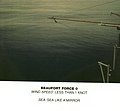
|
|
| 1 | Light air | 1–3 knots 1–3 mph 1–5 km/h 0.3–1.5 m/s |
0–1 ft 0–0.3 m |
Ripples with appearance of scales are formed, without foam crests | Direction shown by smoke drift but not by wind vanes | 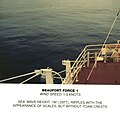
|
|
| 2 | Light breeze | 4–6 knots 4–7 mph 6–11 km/h 1.6–3.3 m/s |
1–2 ft 0.3–0.6 m |
Small wavelets still short but more pronounced; crests have a glassy appearance but do not break | Wind felt on face; leaves rustle; wind vane moved by wind | 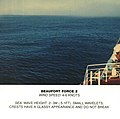
|
|
| 3 | Gentle breeze | 7–10 knots 8–12 mph 12–19 km/h 3.4–5.4 m/s |
2–4 ft 0.6–1.2 m |
Large wavelets; crests begin to break; foam of glassy appearance; perhaps scattered white horses | Leaves and small twigs in constant motion; light flags extended | 
|
|
| 4 | Moderate breeze | 11–16 knots 13–18 mph 20–28 km/h 5.5–7.9 m/s |
3.5–6 ft 1–2 m |
Small waves becoming longer; fairly frequent white horses | Raises dust and loose paper; small branches moved | 
|
|
| 5 | Fresh breeze | 17–21 knots 19–24 mph 29–38 km/h 8–10.7 m/s |
6–10 ft 2–3 m |
Moderate waves taking a more pronounced long form; many white horses are formed; chance of some spray | Small trees in leaf begin to sway; crested wavelets form on inland waters | 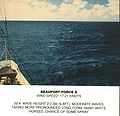
|
|
| 6 | Strong breeze | 22–27 knots 25–31 mph 39–49 km/h 10.8–13.8 m/s |
9–13 ft 3–4 m |
Large waves begin to form; the white foam crests are more extensive everywhere; probably some spray | Large branches in motion; whistling heard in telegraph wires; umbrellas used with difficulty | 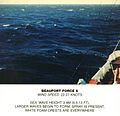
|

|
| 7 | Moderate gale, near gale |
28–33 knots 32–38 mph 50–61 km/h 13.9–17.1 m/s |
13–19 ft 4–5.5 m |
Sea heaps up and white foam from breaking waves begins to be blown in streaks along the direction of the wind; spindrift begins to be seen | Whole trees in motion; inconvenience felt when walking against the wind | 
|

|
| 8 | Gale, fresh gale |
34–40 knots 39–46 mph 62–74 km/h 17.2–20.7 m/s |
18–25 ft 5.5–7.5 m |
Moderately high waves of greater length; edges of crests break into spindrift; foam is blown in well-marked streaks along the direction of the wind | Twigs break off trees; generally impedes progress | 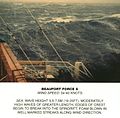
|
 
|
| 9 | Strong/severe gale | 41–47 knots 47–54 mph 75–88 km/h 20.8–24.4 m/s |
23–32 ft 7–10 m |
High waves; dense streaks of foam along the direction of the wind; sea begins to roll; spray affects visibility | Slight structural damage (chimney pots and slates removed) | 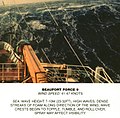
|
 
|
| 10 | Storm, whole gale |
48–55 knots 55–63 mph 89–102 km/h 24.5–28.4 m/s |
29–41 ft 9–12.5 m |
Very high waves with long overhanging crests; resulting foam in great patches is blown in dense white streaks along the direction of the wind; on the whole the surface of the sea takes on a white appearance; rolling of the sea becomes heavy; visibility affected | Seldom experienced inland; trees uprooted; considerable structural damage | 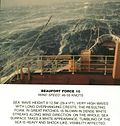
|

|
| 11 | Violent storm | 56–63 knots 64–72 mph 103–117 km/h 28.5–32.6 m/s |
37–52 ft 11.5–16 m |
Exceptionally high waves; small- and medium-sized ships might be for a long time lost to view behind the waves; sea is covered with long white patches of foam; everywhere the edges of the wave crests are blown into foam; visibility affected | Very rarely experienced; accompanied by widespread damage | 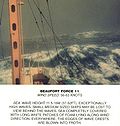
|

|
| 12 | Hurricane-force | ≥ 64 knots ≥ 73 mph ≥ 118 km/h ≥ 32.7 m/s |
≥ 46 ft ≥ 14 m |
The air is filled with foam and spray; sea is completely white with driving spray; visibility very seriously affected | Devastation | 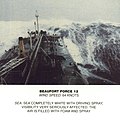
|
 
|
The Beaufort scale is neither an exact nor an objective scale; it was based on visual and subjective observation of a ship and of the sea. The corresponding integral wind speeds were determined later, but conversions have not been made official.
Extended scale
The Beaufort scale was extended in 1946 when forces 13 to 17 were added. However, forces 13 to 17 were intended to apply only to special cases, such as tropical cyclones. Nowadays, the extended scale is used in Taiwan, mainland China and Vietnam, which are often affected by typhoons. Internationally, the World Meteorological Organization Manual on Marine Meteorological Services (2012 edition) defined the Beaufort Scale only up to force 12 and there was no recommendation on the use of the extended scale.
| Beaufort number |
Wind speed |
|---|---|
| 13 | 72–80 knots 83–92 mph 133–148 km/h |
| 14 | 81–89 knots 93–103 mph 149–165 km/h |
| 15 | 90–99 knots 104–114 mph 166–183 km/h |
| 16 | 100–108 knots 115–125 mph 184–200 km/h |
| 17 | > 108 knots > 125 mph > 200 km/h |
Use
The scale is used in the Shipping Forecasts broadcast on BBC Radio 4 in the United Kingdom, and in the Sea Area Forecast from Met Éireann, the Irish Meteorological Service. Met Éireann issues a "Small Craft Warning" if winds of Beaufort force 6 (mean wind speed exceeding 22 knots) are expected up to 10 nautical miles offshore. Other warnings are issued by Met Éireann for Irish coastal waters, which are regarded as extending 30 miles out from the coastline, and the Irish Sea or part thereof: "Gale Warnings" are issued if winds of Beaufort force 8 are expected; "Strong Gale Warnings" are issued if winds of Beaufort force 9 or frequent gusts of at least 52 knots are expected.; "Storm Force Warnings" are issued if Beaufort force 10 or frequent gusts of at least 61 knots are expected; "Violent Storm Force Warnings" are issued if Beaufort force 11 or frequent gusts of at least 69 knots are expected; "Hurricane Force Warnings" are issued if winds of greater than 64 knots are expected.
This scale is also widely used in the Netherlands, Germany, Greece, China, Taiwan, Hong Kong, Malta, and Macau, although with some differences between them. Taiwan uses the Beaufort scale with the extension to 17 noted above. China also switched to this extended version without prior notice on the morning of 15 May 2006, and the extended scale was immediately put to use for Typhoon Chanchu. Hong Kong and Macau retain force 12 as the maximum.
In the United States of America, winds of force 6 or 7 result in the issuance of a small craft advisory, with force 8 or 9 winds bringing about a gale warning, force 10 or 11 a storm warning ("a tropical storm warning" being issued instead of the latter two if the winds relate to a tropical cyclone), and force 12 a hurricane-force wind warning (or hurricane warning if related to a tropical cyclone). A set of red warning flags (daylight) and red warning lights (night time) is displayed at shore establishments which coincide with the various levels of warning.
In Canada, maritime winds forecast to be in the range of 6 to 7 are designated as "strong"; 8 to 9 "gale force"; 10 to 11 "storm force"; 12 "hurricane force". Appropriate wind warnings are issued by Environment Canada's Meteorological Service of Canada: strong wind warning, gale (force wind) warning, storm (force wind) warning and hurricane-force wind warning. These designations were standardised nationally in 2008, whereas "light wind" can refer to 0 to 12 or 0 to 15 knots and "moderate wind" 12 to 19 or 16 to 19 knots, depending on regional custom, definition or practice. Prior to 2008, a "strong wind warning" would have been referred to as a "small craft warning" by Environment Canada, similar to US terminology. (Canada and the USA have the Great Lakes in common.)
Weather scale
Beaufort's name was also attached to the Beaufort scale for weather reporting:
| Symbol | Interpretation |
|---|---|
| a | active |
| b | blue sky |
| c | detached clouds |
| d | drizzling rain |
| f | fog |
| g | dark, gloomy |
| h | hail |
| l | lightning |
| m | misty (hazy) |
| o | overcast |
| p | passing showers |
| q | squally |
| r | rain |
| s | snow |
| t | thunder |
| u | ugly (threatening) |
| v | visibility (unusual transparency) |
| w | wet, dew |
In this scale the weather designations could be combined, and reported, for example, as "s.c." for snow and detached cloud or "g.r.q." for dark, rain and squally.
See also
- Bowditch's American Practical Navigator
- CLIWOC
- Douglas sea scale
- Extratropical cyclone
- Sea state
- Squall
- Tornado intensity
- Tropical cyclone intensity scales
References
- Huler, Scott (2004). Defining the Wind: The Beaufort Scale, and How a 19th-Century Admiral Turned Science into Poetry. Crown. ISBN 1-4000-4884-2.
- ^ Saucier, Walter Joseph (1955). Principles of Meteorological Analysis. Chicago: The University of Chicago Press. OCLC 1082907714., reprinted in 2003 by Dover Publications.
- ^ "National Meteorological Library and Archive Fact sheet 6 – The Beaufort Scale" (PDF). Met Office. Archived from the original (PDF) on 2 October 2012. Retrieved 13 May 2011.
- Oliver, John E. (2005). Encyclopedia of world climatology. Springer.
- McIlveen, Robin (1991). Fundamentals of Weather and Climate. Cheltenham, England: Stanley Thornes. p. 40. ISBN 978-0-7487-4079-6.
- Hay, William W. (2016). Experimenting on a Small Planet: A History of Scientific Discoveries, a Future of Climate Change and Global Warming (second ed.). Cham, Switzerland: Springer Verlag. p. 26. ISBN 978-3-319-27402-7.
- Beer, Tom (1997). Environmental Oceanography. CRC Press. ISBN 0-8493-8425-7.
- Maiden, Terence. "T-Scale: Origins and Scientific Basis". TORRO. Archived from the original on 5 February 2012. Retrieved 4 January 2012.
- "The Beaufort Scale". RMetS. Retrieved 6 July 2021.
- "Beaufort wind force scale". Met Office. Retrieved 27 November 2015.
- "Beaufort Scale". Royal Meteorological Society. Retrieved 27 November 2015.
- "Beaufort Scale". Encyclopædia Britannica. Retrieved 27 November 2015.
- ^ The names "storm" and "hurricane" on the Beaufort scale refer only to wind strength, and do not necessarily mean that other severe weather (for instance, a thunderstorm or tropical cyclone) is present. To avoid confusion, strong wind warnings will often speak of e.g. "hurricane-force winds".
- "FAQ for Marine: 2. Beaufort Wind Scale Table?". Central Weather Administration. 14 August 2024. Retrieved 7 September 2024.
- "天气预报基本术语" [Basic terminology for weather forecast] (PDF). China Meteorological Administration (in Chinese). p. 10. Retrieved 7 September 2024.
- "Quyết định số 18/2021/QĐ-TTg của Thủ tướng Chính phủ: Quy định về dự báo, cảnh báo, truyền tin thiên tai và cấp độ rủi ro thiên tai" [Decision No. 18/2021/QĐ-TTg of the Prime Minister: Regulations on forecasting, warning, communication of natural disaster and natural disaster risk levels]. Vietnam Government Portal (in Vietnamese). p. 60. Retrieved 7 September 2024.
- Manual on Marine Meteorological Services: Volume I – Global Aspect (PDF). World Meteorological Organization. 2012. Archived from the original (PDF) on 5 May 2017.
- "JetStream Max: Wind and Sea Scales". National Oceanic and Atmospheric Administration. Retrieved 10 December 2023.
- "Wetterlexikon - Beaufort-Skala" (in German). Deutscher Wetterdienst. Archived from the original on 12 December 2013. Retrieved 14 February 2014.
- "昨日实行新标准"珍珠"属强台风_新闻中心_新浪网". news.sina.com.cn.
- "The Times". The Times. 29 April 1873. p. 10. ISSN 0140-0460. Retrieved 3 July 2020.
External links
- National Meteorological Library and Archive Archived 13 November 2017 at the Wayback Machine fact sheet on the history of the Beaufort Scale, including various scales and photographic depictions of the sea state.
- Film of Wind Scale
- Historical Wind Speed Equivalents Of The Beaufort Scale
- Howtoons Poster showing effects on land/sea effects at each step.
- Beaufort scale, cites the original definition formula
- Ireland's Beaufort was Windscale Inventor—by Dr John de Courcy Ireland
- The Beaufort Scale and Weather Diaries of Rear Admiral Sir Francis Beaufort—The history of the Beaufort Scale
- Radio interview with Scott Huler
- Beaufort wind force scale. Met Office
- US Economic Costs of High Winds at NOAA Economics
 )
)